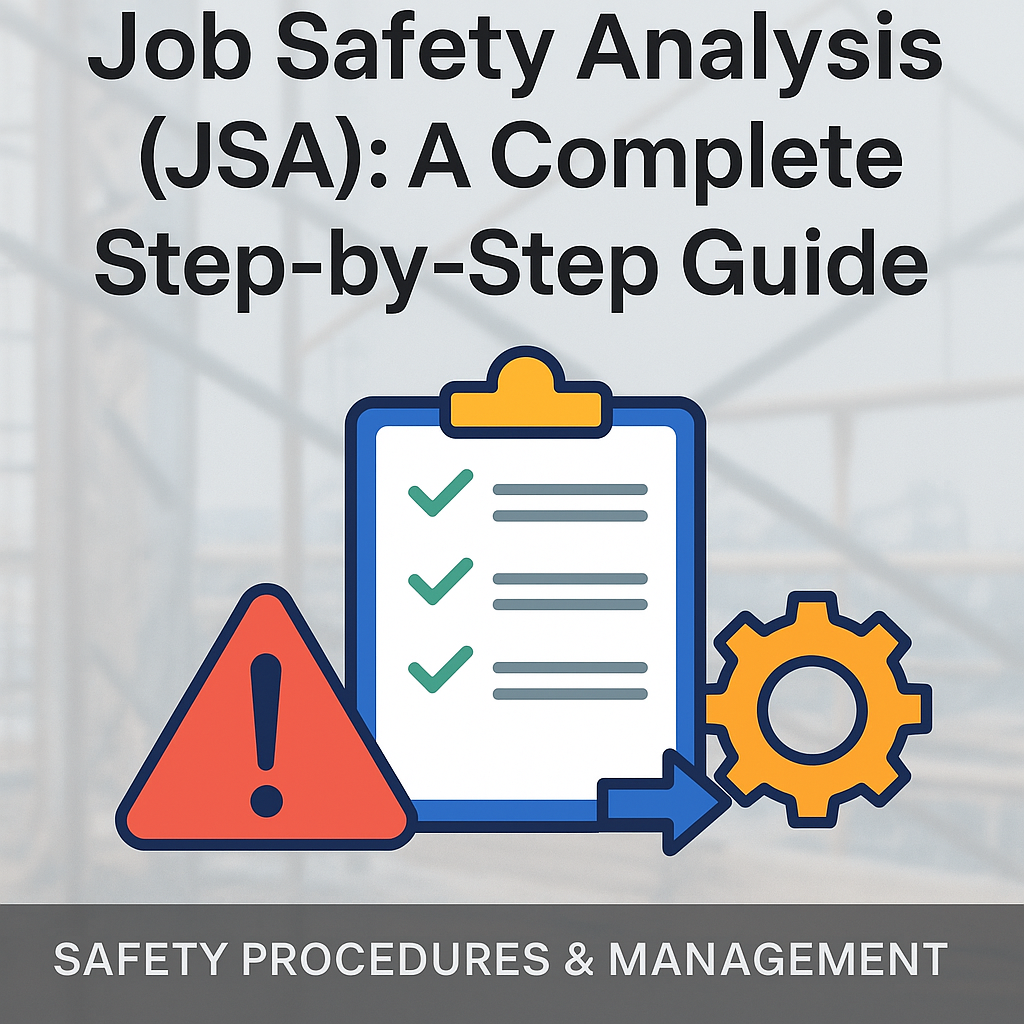
Job Safety Analysis (JSA): A Complete Step-by-Step Guide
🧱 Introduction
A Job Safety Analysis (JSA), also known as Job Hazard Analysis (JHA), is a step-by-step method for identifying hazards associated with specific job tasks and implementing controls to minimize risk. It’s a critical tool for safety professionals across all industries—from construction and manufacturing to healthcare and warehousing.
Whether you’re a new safety officer or a seasoned HSE manager, mastering JSA will help reduce workplace injuries, ensure compliance with standards like OSHA and ISO 45001, and foster a proactive safety culture.
In this guide, we’ll walk you through the entire process, including real-world examples, a downloadable template, and actionable tips for successful implementation.
🔍 What is Job Safety Analysis (JSA)?
A Job Safety Analysis (JSA) is a systematic process that breaks down a job into specific tasks, identifies potential hazards for each step, and recommends preventive measures to eliminate or reduce the risks. It bridges the gap between risk assessments and task-level planning, making it essential for daily operations.
✅ Benefits of Conducting a JSA
- Reduces workplace accidents
- Enhances task-specific training
- Ensures legal compliance (e.g., OSHA 29 CFR 1910)
- Identifies areas for procedural improvement
- Promotes employee involvement in safety
⚙️ Step-by-Step JSA Process
📍 Step 1: Select the Job to Be Analyzed
Choose tasks that:
- Have a history of incidents
- Are non-routine or new
- Involve complex equipment or environments
📍 Step 2: Break the Job into Tasks
List the job steps in sequential order (3 to 10 steps per task is ideal).
🧠 Example – Task: Cleaning a chemical spill
- Notify supervisor
- Put on PPE
- Isolate the area
- Clean with approved materials
- Dispose of waste safely
📍 Step 3: Identify Hazards
For each step, ask:
- What can go wrong?
- What are the consequences?
- What could cause it?
- How likely is it?
📍 Step 4: Determine Control Measures
Apply the Hierarchy of Controls:
- Elimination
- Substitution
- Engineering Controls
- Administrative Controls
- Personal Protective Equipment (PPE)
🛠 Tip: Use checklists and a risk matrix to help during this stage.
📍 Step 5: Record and Implement
Document the findings in a JSA form and ensure all workers are briefed.
📋 Fields to include:
- Task Description
- Step-by-Step Breakdown
- Hazards Identified
- Control Measures
- Responsible Person
- Review Date
📍 Step 6: Monitor and Review
- Conduct periodic reviews (every 6–12 months)
- Reassess when changes occur (e.g., new equipment or procedures)
🔁 Safety is dynamic; your JSA must be too.
🧾 Sample JSA Checklist Format
| Step No. | Job Step Description | Potential Hazards | Recommended Controls | Responsible Person |
|---|---|---|---|---|
| 1 | Put on PPE | Slips, incorrect use | Train on PPE donning | Safety Officer |
| 2 | Isolate area | Exposure to chemicals | Use signage, barricades | Supervisor |
| 3 | Clean spill | Chemical burns | Use proper tools, gloves | Trained Worker |
| 4 | Dispose waste | Inhalation risk | Seal and label waste | Waste Handler |
📌 Pro Tip: Keep your JSA documents readily available for audits and incident investigations.
❓ Frequently Asked Questions (FAQs)
1. Is Job Safety Analysis mandatory?
Not always legally mandated, but OSHA strongly recommends it for hazardous tasks. ISO 45001 emphasizes JSA under its risk-based approach.
2. How often should a JSA be reviewed?
At least once a year or whenever changes occur in equipment, processes, or personnel.
3. Who should perform a JSA?
Ideally, a team of supervisors, safety officers, and experienced workers who understand the job task.
4. Can JSA be used for routine jobs?
Yes. Even familiar jobs need periodic reassessment to prevent oversight due to routine behavior.
5. Is JSA the same as a risk assessment?
No. Risk assessments are broader; JSAs are task-specific, offering detailed analysis at the task level.
🌐 External Resources
🔗 OSHA Job Hazard Analysis Guide (PDF)
📌 Final Thoughts
Job Safety Analysis is more than just a compliance tool—it’s a proven method to engage workers, reduce workplace risks, and foster a proactive culture of safety. From minor tasks to high-risk operations, JSA helps maintain control, accountability, and continuous improvement.
If your workplace isn’t using JSA yet, start small with high-risk jobs and scale the practice. Over time, your team will appreciate the value, and your incident rates will reflect the improvement.
Permit to Work System: Step-by-Step Guide for Safer Workplaces
Emergency Preparedness in the Workplace: 7 Key Steps to Protect Your Team
Workplace Safety Procedures: Top 10 Practices Every Company Must Follow
Top 10 Common Safety Hazards in Manufacturing and How to Prevent Them




















